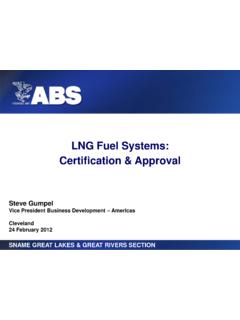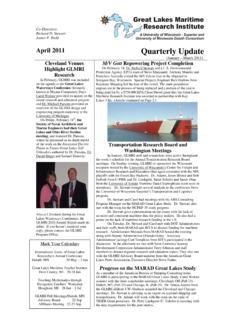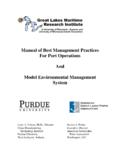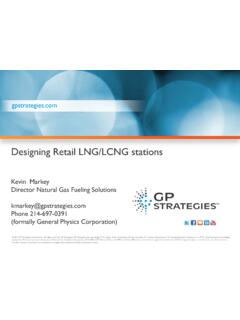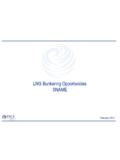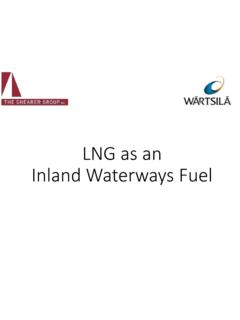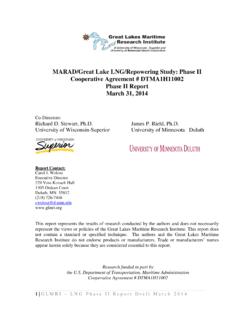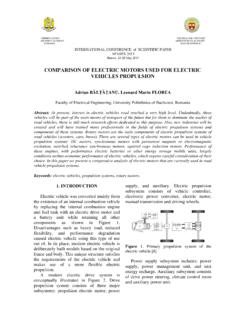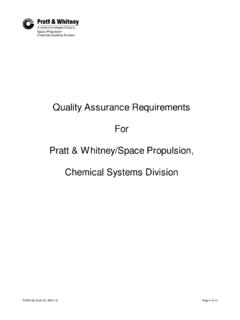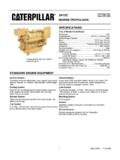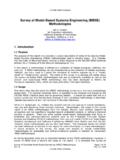Transcription of Gas engine propulsion in ships - University of Minnesota ...
1 Gas engine propulsion in ships Safety considerations Torill Grimstad Osberg, DNV. Washington, June 2008. Background Summary of projects with gas engines in ships Safety regulations - How are the installations made safe? - engine room arrangement - Tank design and location - Gas piping systems - International rules on the way Det Norske Veritas AS. All rights reserved June 2008 Slide 2. Background Det Norske Veritas AS. All rights reserved June 2008 Slide 3. Background before year 2000. CNG driven ships in Russia, Netherlands, US, Canada, Australia Gas engines installations for maritime/ offshore use (mainly FPSOs). LNG/LPG Carriers - gas propulsion , gas piping, gas tanks, materials, testing and so on Det Norske Veritas AS. All rights reserved June 2008 Slide 4. Gas fuelled ships - since 2000. The LNG fuelled car and passenger ferry Glutra Gas engines located in 4.
2 Separate machinery spaces In full operation since January 2000- excellent performance Photo: Harald Valdehaug Det Norske Veritas AS. All rights reserved June 2008 Slide 5. Gas fuelled ships - since 2000. Platform supply vessels (PSVs) Viking Energy and Stril Pioneer: Worlds first LNG fuelled cargo ships delivered 2003 (dual fuel engines). Det Norske Veritas AS. All rights reserved June 2008 Slide 6. Gas fuelled ships - since 2000. Small LNG tanker Pioneer Knutsen delivered in June 2004 (gas and diesel engines, DNV class). 3 LNG tankers built in France, delivered 2006/2007 (BV). Numerous LNG tankers on contract in Korea with dual fuel engines (33 vessels on order April 2008 ( ) -different class societies, including DNV. Additional small coast trade LNG tanker to be delivered 2008 (RINA). Det Norske Veritas AS. All rights reserved June 2008 Slide 7. Gas fuelled ships - since 2000.)
3 5 LNG fuelled car and passenger ferries January/February 2007 (gas only engines). LNG fuelled platform supply vessel, Viking Queen and Viking Lady, first is delivered (dual fuel engines). More ferries contracted now (3 different types including HSLC for Brazil). Photo: Skipsrevyen Photo: Harald Valdehaug Det Norske Veritas AS. All rights reserved June 2008 Slide 8. Gas fuelled ships - since 2000. LNG fuelled coast guard vessels- first to be delivered March 2008 (gas and diesel engines) 3 vessels contracted Det Norske Veritas AS. All rights reserved June 2008 Slide 9. Coast guard vessels engine room Det Norske Veritas AS. All rights reserved June 2008 Slide 10. RoRo/ RoPax BigLNG project - Research project (ColorLine, SeaTrans, Marintek, DNV, AkerYards, GasNor). Two designs developed, one for RoRo one for RoPax Det Norske Veritas AS. All rights reserved June 2008 Slide 11.
4 engine types used Lean burn prechamber spark ignited engine from Mitsubishi (low pressure Otto cycle). - Ferry Glutra - Knutsen Pioneer LNG tanker - Coast guard vessels - Some of the ferries on contract Lean burn prechamber spark ignited engine from Rolls Royce (low pressure Otto cycle). - Ferries delivered in 2007 (Bergensfjord, Stavangerfjord, Mastrafjord, Raunefjord, Fanafjord). - New RORO project Sea-Cargo Dual fuel (DF) engines (DF engine work as an ordinary diesel engine in diesel mode and as a pilot ignited Lean burn gas engine (low pressure Otto cycle) in the gas mode): - Gas supply vessels Viking Energy, Stril Pioneer, Viking Queen and Viking Lady (W rtsil DF). - LNG tankers France and Korea (W rtsila DF, MAN Diesel DF). - FPSOs Gas Diesel: - FPSOs Det Norske Veritas AS. All rights reserved June 2008 Slide 12. Main challenges with natural gas as fuel Explosion risk - Range 5-15% mixture in air - Ignition source present - Where in the ship ?
5 - engine room - Gas storage space - Bunkering station - Gas piping through the ship : - Between bunkering station and tank - Between tank and engine room Low temperature of liquid gas - LNG at -163 C. - Special material, protection of normal ship steel Gas tank large energy content Det Norske Veritas AS. All rights reserved June 2008 Slide 13. Rules and Regulations - Gas as Fuel DNV Rules Gas fuelled engine installations issued January 2001. - Applicable to all ship types - The part of these Rules addressing engine room installations are also relevant for LNG carriers Use of gas as fuel in ships other than LNG carriers need acceptance by flag state due to lack of international conventions International work in IMO: Interim guidelines/ code for gas fuelled ships in progress. - Based on the same principles as DNV rules Det Norske Veritas AS. All rights reserved June 2008 Slide 14.
6 engine room safety principle DNV Rules and IMO draft defines two concepts for safety against gas hazards in machinery spaces - Inherently gas safe machinery space. The two-barrier concept as known from the IGC Code - ESD protected machinery space. Single wall gas piping accepted. Det Norske Veritas AS. All rights reserved June 2008 Slide 15. Inherently gas safe machinery space Double piping all the way into the engine (similar to IGC code). Inherently gas safe engine room . All gas pipes in engine room are enclosed in a double pipe/ duct that can withstand the pressure build up during pipe rupture Double pipe/ duct to be pressurised and filled with inert gas or ventilated and with gas detection The concept is mandatory for high pressure piping (>10 bar), but can also be used with low pressure installations Ordinary machinery space Gas pipe Main engine Double pipe Det Norske Veritas AS.
7 All rights reserved June 2008 Slide 16. ESD protected engine rooms Smaller low pressure gas engines have gas supply piping which is difficult to arrange with complete jacketing Emergency ShutDown (ESD) protection Lean burn pre-chamber spark ignited engine from Mitsubishi (low pressure Otto cycle). Det Norske Veritas AS. All rights reserved June 2008 Slide 17. ESD protected engine rooms The ESD protected machinery space is considered Gas Safe in the normal mode but changes status to Gas Dangerous on detection of gas Gas detection system with at least 3 detectors in ER- redundant system required - Gas is detected at 20% of LEL (lower explosion limit) on one detector . Alarm (can switch to diesel for dual fuel engines). - Two detectors read 20% LEL. the fuel supply automatically to be shut down all non explosion protected equipment is to be electrically disconnected.
8 Det Norske Veritas AS. All rights reserved June 2008 Slide 18. ESD protected engine rooms Because of the shut-down requirement for an ESD Protected engine room, the power generation for propulsion and manoeuvring must be divided between two or more engine rooms independent of each other ESD protected Inherently safe engine room engine room space ESD protected engine room Det Norske Veritas AS. All rights reserved June 2008 Slide 19. ESD protected machinery space - Ventilation: 30 air changes / hour - Gas detection -Automatic shut down of gas supply and Gas engine room, ESD. disconnection of protected electrical equipment - Excess flow shut down Gas engine room, ESD. protected = potential gas danger = gas dangerous zone Det Norske Veritas AS. All rights reserved June 2008 Slide 20. Arrangement on LNG supply vessels LNG tank Bulkhead Dual fuel engines Det Norske Veritas AS.
9 All rights reserved June 2008 Slide 21. Tank design LNG tanks to be of independent type, to be approved in accordance with requirements in IGC code Compressed gas tanks to be approved in accordance with recognized standards Det Norske Veritas AS. All rights reserved June 2008 Slide 22. Rules- Gas storage Tanks located above deck - CNG and LNG accepted - Location at least B/5 from ship side - Drip tray below LNG tank required if tank has connections below liquid level Tanks located below deck - Compressed gas normally not accepted, maximum pressure 10 bar - Secondary barrier around LNG tank called tank room in the rules - Stainless steel or equivalent low temperature resistant material - Designed to withstand maximum pressure build up, alt. pressure relief venting arranged - Thermal isolation towards ship steel required Det Norske Veritas AS. All rights reserved June 2008 Slide 23.
10 Rules- Gas storage Location below deck Top view Liquefied gas tank Min. the lesser of B/5 and 11,5 m Never less than 760 mm Side view Min. the lesser of B/15 and 2 m Never less than 760 mm Det Norske Veritas AS. All rights reserved June 2008 Slide 24. Tank location Det Norske Veritas AS. All rights reserved June 2008 Slide 25. Tank arrangement on gas supply vessels VACUUM BUNKERING LINES AND TANK. INSULATED VENTILATION PIPES IN VENTILATED DUCT GAS DETECTORS. TANK WITH GAS DETECTION. INSULATED COLD BOX. Tank room DUCT PIPE -GAS LINE. ALL TANK VALVES. LOCATED IN COLD. BOX. TANK SADDLE WATER VAPORIZER. IN/OUT. Det Norske Veritas AS. All rights reserved June 2008 Slide 26. Rules- bunkering arrangement & piping P P. GD Ventilation M. to open GD. air Gas detectors Min. 760 mm To gas tank Det Norske Veritas AS. All rights reserved June 2008 Slide 27. Rules- hazardous and safe areas Rules define which spaces and areas are gas hazardous Requirements are set to the electrical equipment to be used in the different zones (zone 0,1, 2).
